Review of Kumbha Mela, 1998
Paramhans Swami Maheshwaranandaji's inauguration as Sarvabhaum Sanatan Dharma Jagadguru
On 10th April, 1998, Paramhans Swami Maheshwaranandaji was inaugurated by the World Religious Parliament as "Sarvabhaum Sanatan Dharma Jagadguru".
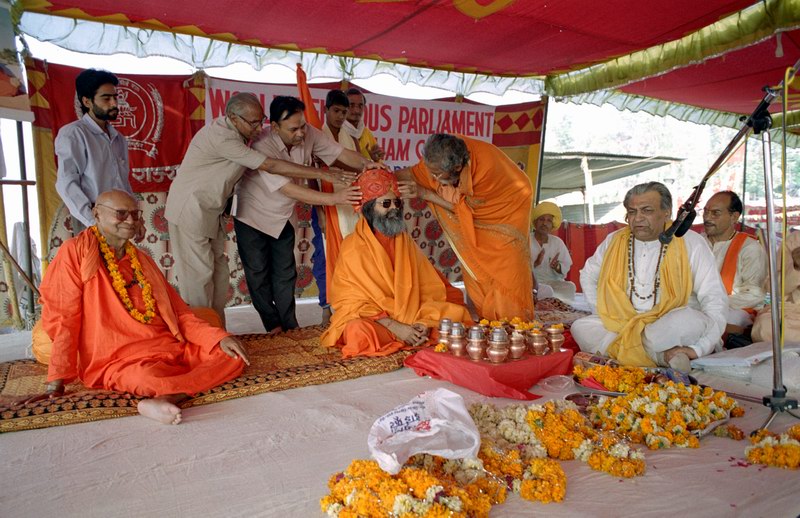
Admidst the chanting of Vedic mantras, yagya and havan, the holy puja was performed and water from 25 different rivers of the country was used in the abhisekh (coronation) with the royal turban. Yugacharya Prabhakar Mishra, President of Universal Sanatan Foundation and World Religious Parliament (India) solemnly proclaimed Paramhans Swami Maheshwarananda as "Sarvabhaum Sanatan Dharma Jagadguru" much to the delight of all assembled persons.
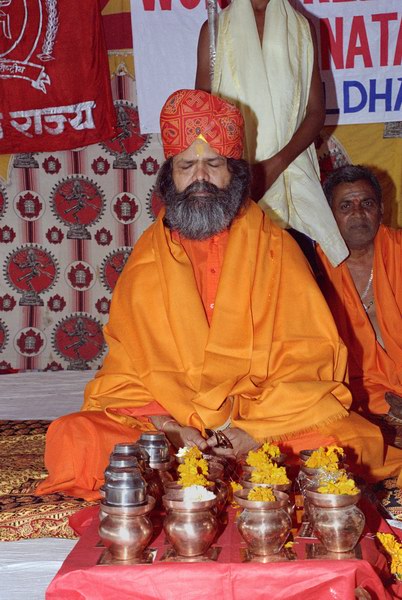
Swamiji’s speech after coronation
Sarvbhaum Sanatan Dharma Jagadguru Paramhans Sri Swami Maheshwaranandaji addressed the auditory with words of blessing: "OM Gurur Brahma, Gurur Vishnu, Guru Devo Maheshwarah Gurur Sakshat Parabrahma, Tasmey Sri Guruve Namah – Sanatan dharma adi anadi dharm hain. Sanatan Dharma means eternal dharma, eternal duty, religion and relationship. Religion is closely related to "realize" – realize your relation, your true relatives, your position within nature and the Universe. Realize your unity with God and all living beings. Religious and spiritual practices have built the fundamental background of daily life in India. Spiritual dharma does not mean to withdraw from the world, on the contrary, it means to come closer to mankind. There is no wish to convert anybody but rather to convince people by living a good example. Therefore many saints and yogis have travelled to other parts of the world to share the message of spiritual truth and unity to all humankind. We want to show people a path to physical, mental, social and spiritual healing. A path which leads to the highest goal, God–realization.
I thank the World Religious Parliament for the great honour which they conveyed upon me and I pray to the Almighty Lord to grant me the right thoughts and acts for this position, to spread the light of Sat Sanatan Dharma and the eternal values of spiritual Truth all over the world. Especially I convey my thanks to the President of the World Religious Parliament, Brahmrishi Acharya Prabhakar Mishra for his ceaseless work and efforts in the service of mankind. I pray for his health, long life and God's blessing for his further activities. But before all I wish to give my humble Pranams and deepest gratitude to my beloved Gurudev Paramhans Swami Madhavanandaji, that he has lead me to this high position."
Bestowed titles
As per desire of the President of World Religious Parliament, Sarvbhaum Sanatan Dharma Jagadguru Paramhans Swami Maheshwarananda bestowed the title of "Sanatan Dharma Mahamandaleshwar" on Siddha Baba of Allahabad, Sant Swami Parmanandaji of Haiderabad and Swami Ram Krishna Das ji of Morena. He also bestowed the title of "Vishwa Gaurav" (Glory of the Universe) on Yogeshwar Paramhansa Swami Adgadanandaji and Jagadguru Ramanandacharya Sri Ram Bhadracharya of Chitrakoot. Twenty-three persons from India and other countries received the titles of "Brahm kul Bhusan" (Jewel among Brahmins) and "Bharat Gaurav" (Glory of India).
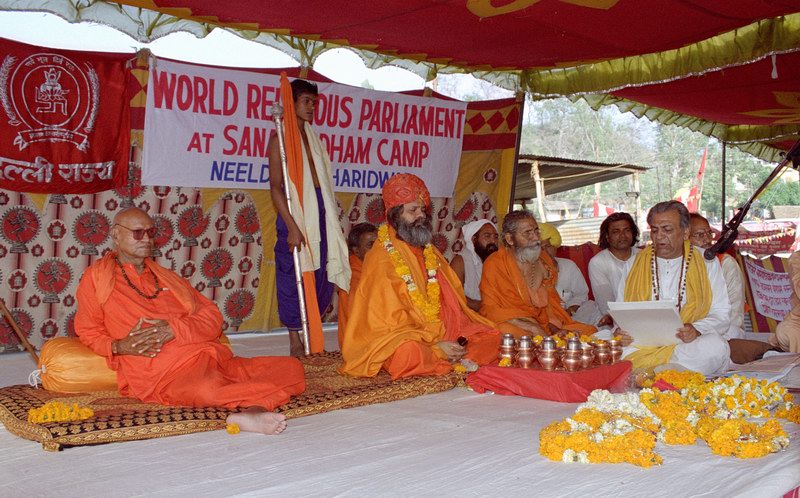
Paramhans Swami Maheshwaranandaji's inauguration as Mahamandaleshwar of Maha Nirvani Akhara
On 14th April, 1998, the holiest day to dip into the river Ganga, Paramhans Swami Maheshwaranandaji was coronated as Mahamandaleshwar. With the chanting of Vedic mantras, Swamiji performed puja, following the directions of the pandits.
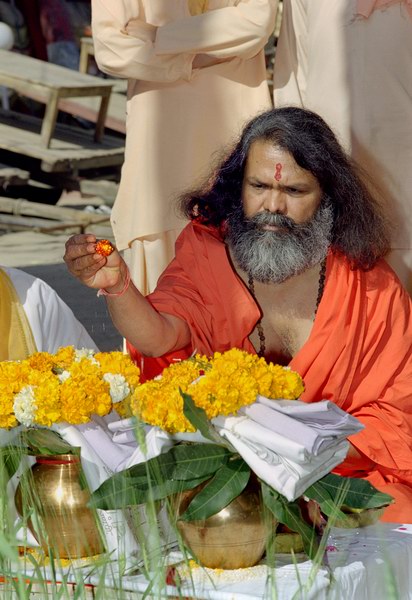
According to sacred tradition, he received abhishekh tilak and abhishekh kalash.
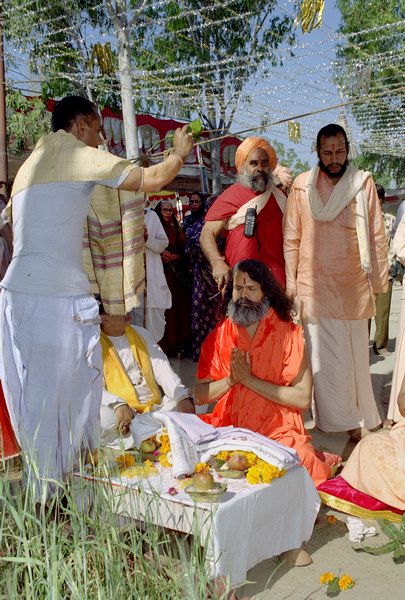
Subsequently, Swamiji was taken to a very spacious and high platform, adorned with the presence of dozens of Mahamandaleshwars, Mahants, Secretaries of akharas and the head Priests of many temples.
After Swamiji was formally declared a Mahamandaleshwar by the Secretary of the Mahanirvani Akhara, all the Mahamandaleshwars, Mahants, Saints and Pandits greeted him and wrapped shawls around his shoulders as a token of their blessing.
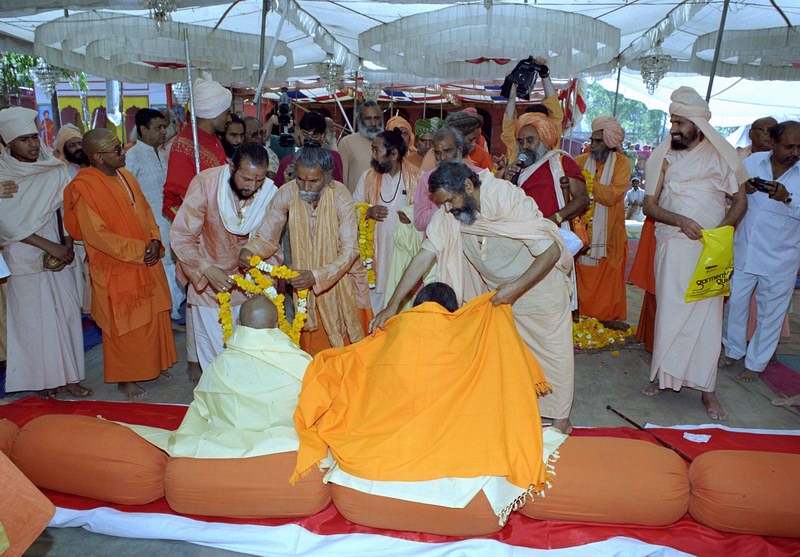
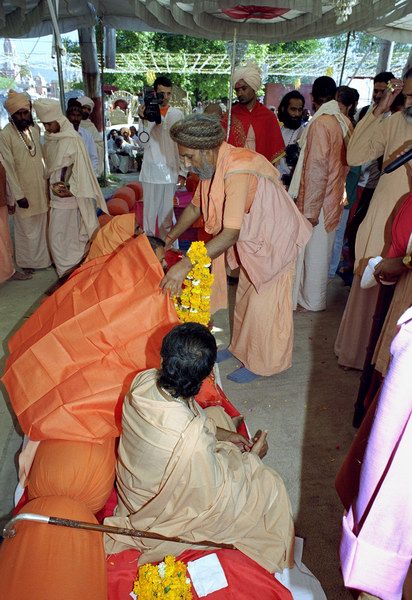
The Secretary of the akhara highlighted the prominent role carried by Swamiji in propagating the eternal values of Sanatan Dharma and Yoga in Daily Life in the different parts of the world.
Sri Mahamandaleshwar Swami Niranjananda Giriji, acquainted the audience with the Swamiji’s activities worldwide and welcomed his coronation as Mahamandaleshwar.
The Peetadeshwar Acharya (head of the akhara) Mahamandaleshwar 108 Sri Swami Vishwadevanandji spoke of the time honoured, high tradition of the akhara, and said that in Swamiji Maheshwarananda, the akhara was now going to have a Mahamandaleshwar who is as proficient in speaking English and German as he is in speaking Hindi. He added that Swamiji would prove a great asset to the akhara and widen the sphere of its activities.
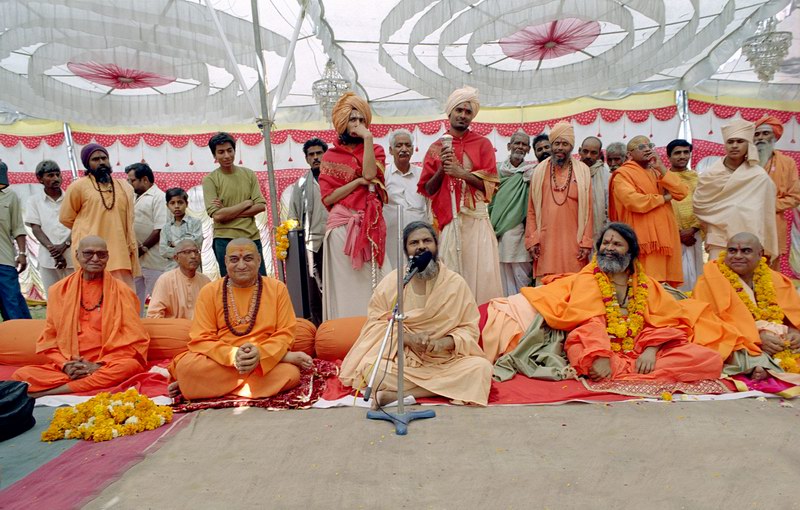
His Holiness Sri Mahamandaleshwar Paramhans Swami Maheshwarananda Puriji Maharaj thanked all the assembled Saints, Scholars and Mahamandaleshwars, and assured them that he would live and work according to the traditions of the akhara, and continue the spiritual and humanitarian work he has embarked upon under the inspiring guidance of his Guru.
Dharma Chakravarti Paramhans Swami Madhavanandaji also thanked the Acharya and other Mahamandaleshwars for receiving Swamiji into their fold, and affectionately recalled many incidents from Swamiji‘s early life which had convinced him of his great genius and dedication to religion.
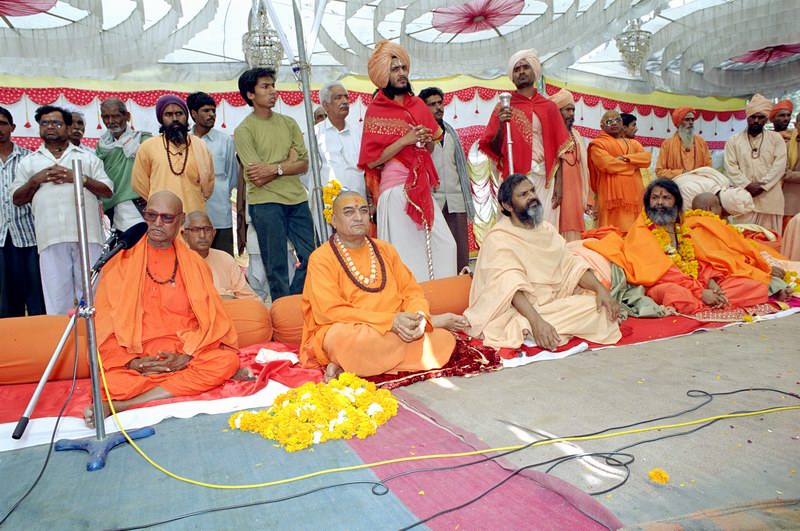
Historical backgrounds of the Akharas
Adi Shankar and his four principal disciples
Adi Shankar had four principal disciples – Padampad, Hastamalak, Sureshwar and Trotak. He founded the four peeths – Jyotir Math in the North, Shringeri Math in South, Govardhan Math in Jagannath Puri in East and Sarada Math in the West and made each of his four disciples their head. The disciples of Hastamalak (Govardhan Math, Jagannath Puri) write "Van" and "Aranya" after their names. The disciples of Sureshwar (Jyotir Math, Badri Math) write "Giri", "Parvat" and "Sagar" after their names. The disciples of Trotak (Shringeri Math) write "Puri", "Bharthi" and "Sarasvati" after their names. Thus, all sannyasis used either of these surnames and this gave birth to the institution of Dasnami (ten names) among the sannyasis. The principal Shaiva subsect established by Shankara, the "Dasnami" sannyasis, are known as Vedic Shaiva. Integrated to the monastic order are the nagas. Dasnamic ascetics have been divided into two categories, (a) those who hold the scriptures viz Shastradhari and (b) those who hold arms viz Astradhari.
Sanatan Dharma and young sadhus
During the invasions of Mahmud Gazuri, Mohammad Ghori and Taimur, thousands of Hindu temples were levelled to the ground, and millions of Hindus killed. Things were no better during the Muslim rule in India. Realizing the dangers of oppression and persecution of the votaries of Sanatan Dharma by fanatics and aggressors of other denominations, Adi Shankara realized that spiritual power alone was not sufficient. He insisted upon the younger sadhus to build up muscle power by doing physical exercise and acquiring proficiency in the use of weapons. As such, the maths where such exercises were conducted, came to be known as "akharas" (wrestling places).
Adi Shankara advised the akharas to resist by force, if necessary, the persecution of Hindus and the desecration of their sancutaries. During the Muslim invasions and the Muslim rule, these akharas acted as barriers against attacks on Hindu people, their sacred shrines and institutions. On many occasions, armed members of the akharas valiantly resisted the persecution of the Hindus and desecration of temples. Not infrequently, rulers sought the help of naga soldiers in their war. They have the glorious record of having fought many battles and at times the numerical strength of particular akaharas ranged up to 40,000. After India's independence, these akharas lost their militant character and their Saints have been vigorous in preaching and propagating the eternal values of ancient Indian culture and philosophy.
13 akharas
There are 13 akharas in Haridwar each of them head by a highly revered Saint having a number of Mahamandaleshwars. Most of them have their own ashrams outside Haridwar and their own disciples.
The oldest akhara – Atal Akhara, was founded in 646 A.D. in Gondwana. In the 17th century Rajendra Giri of this akhara captured 114 villages in Jhansi U.P. This akhara was revitalised in 1704 A.D. and its principal seat is Patan though it has an ashram at Kankhal. The present head of the akhara is Acharya Sri Mahamandalweshar Mangalanand Giri.
Maha Nirvani Akhara is an off-shoot of Atal Akhara. On being denied prasad of Gajanandji seven sadhus of Atal Akhara left it and commenced tapas at Gangasagar. They had darshan of Kapil Muni and with his blessings, they established an akhara in 748 A.D. near Neel Dhara in Haridwar. In the year 1260, 22,000 naga Saints, led by their spirited leader Mahant Bhavanand Giri, liberated Kankhal from Muslim aggressors and the present akhara is exactly at the place where they hoisted their first flag. This akhara owns the Daksheswar temple and its present head is Acharya Sri Mahamandaleshwar Vishwadevanand.
Paramhans Sri Swami Maheshwaranandaji Maharaj has become a Mahamandaleshwar of this akhara on April 13, 1998.
Avahan Akhara was established in 646 A.D. and reorganized in 1603. The main seat of this akhara is Dasamegh Ghat of Varanasi. It also has an ashram at Rishikesh. Swami Anupgiri and Umrao Giri of this akhara were famous warriors. The present Acharya is Sri Mahamandaleshwar Swami Shivendra Puri.
Anand AkharaAnand Akhara was established in Berar (in Madhya Pradesh) in 855 A.D. and its main centre is in Varanasi, though it has an ashram in Haridwar. Its Acharya is Mahamandaleshwar Devanand Sarasvati.
Niranjani Akhara was established in Mandvi (Gujarat) in 903 A.D. Its main centre is in Daranganj Allahabad. It has a beautiful ashram at Dam Kothi in Haridwar. Mansadevi and Vilvakesar temples of Haridwar belong to this akhara. Its present Acharya is Sri Mahamandaleshwar Punyanand Giri.
Juna Akhara is also called Bhairav Akhara. It was established in 1145 A.D.in Karan Prayag of Uttarkhand. Its main centre is Mara Hanuman Ghat of Varanasi. Its ashram in Haridwar is near Mayadevi temple which it owns. Its Acharya is Sri Mahamandaleshwar Lokeshanand Giri.
Agni Akhara was established in 1136 A.D. Its Acharya is Sri Mahamandaleshwar Swami Prakashanand Maharaj.
The above named seven akharas are of Naga Saints. Apart from these, there are two akharas of Udasin Sampradaya – Bara Udasin Akhara and Udasin Naya Akhara, one Nirmal Akhara and three Akharas of Vaishnav Bhairagi Sampradaya – Digambar Ani Akhara, Panch Ani Akhara and Nirmohi Ani Akhara.
On the occasion of Shahi Snan (the Royal Bath) of Maha Kumbha Mela, Mahamandaleshwars, Mahants, Acharyas and the heads of all these 13 akharas, proceed in well decorated processions, to bathe at Hari ki Pauri. Their turn for the holy bath are fixed. In the Kumbha Mela, members of the Niranjani Akhara along with its associate Anand Akhara are the first to bathe. They are followed by the members of Juna Akhara. The members of Avahan, Agni, Atal and Mahanirvani Akhara bathe in the third lot on the day of Shahi Snan.